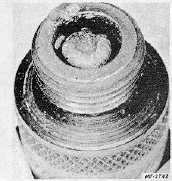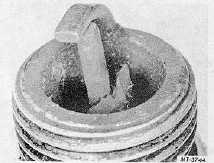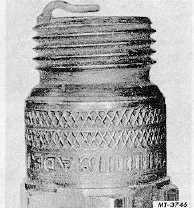|
| |
TRUCK SERVICE MANUAL
TM 5-4210-230-14&P-1
ELECTRICAL
Fig. 12 Sustained Preignition Damage
Chipped Insulator
The chipped insulator shown in Fig. 13 results from bending
the center electrode during regapping of the plug. Under
certain conditions severe detonation can also split insulator
firing ends. Obviously, the plug must be replaced.
Fig. 13 Chipped Insulator
Mechanical Damage
Mechanical damage to plug shown in Fig. 14 is caused by a
foreign object in the combustion chamber. Small objects can
travel from one cylinder to another (because of valve
overlap). Be sure to check the other cylinders to prevent
recurrence of damage. When working on an engine, be
certain the carburetor throat and spark plug holes are kept
covered.
Fig. 14 Results of Mechanical Damage
Reversed Coil Polarity
Reversed coil polarity can often be detected by "dishing" of
the ground electrode. Note in Fig. 15 that the center
electrode is usually not worn badly. This source of misfiring
and rough idle can be corrected by reversing the primary coil
leads.
Fig. 15 Reversed Coil Polarity
Spark Plug Gap Tools
Pressure-type (plier) gap tools, if improperly used, impose a
tremendously high unit pressure on the center electrode (Fig.
16). This is because of compression being exerted between
the end of the center electrode and the top of the shell. If too
much force is applied through leverage multiplication, the
center electrode seal on any type or brand of spark plug is
likely to be damaged. The conventional type gap tool, which
should only contact the ground electrode, is less likely to
damage the plug.
Fig. 16 Damage to Spark Plug from Pressure (Plier)
Type Gap Tools
Condition of Electrodes
The extent of service and mileage to which a spark plug has
been subjected is generally best indicated by the degree of
wear of the electrodes, Fig. 17. When the center electrode
CTS-2016-J Page 6
PRINTED IN UNITED STATES OF AMERICA
|





